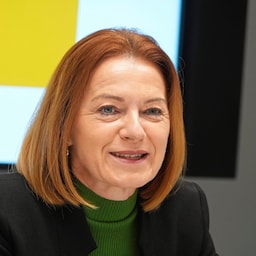New in Styria
Waste system: What belongs in the yellow garbage can from 2025
From next year, the blue metal garbage can will be a thing of the past - instead, there will be new regulations regarding packaging waste and deposits. But how exactly should Styrians separate their waste in future? What is the "yellow formula" all about? We provide answers to the five most important questions.
Light and metal packaging makes up ten percent of our household waste. While the majority of Styrians think of two different garbage cans, the district of Liezen is already considered a pioneer. Instead of separating blue and yellow, plastic and metal packaging end up in the same bin there. And this model will be rolled out throughout Styria and Austria from January 1, 2025. The aim is to simplify collection and increase recycling rates.
The revised system is not as new as you might think: lightweight packaging and metal waste have only been thrown away separately since 1993, explains Andreas Pertl from the Packaging Coordination Office. There are two reasons why they now want to go back to the old system: On the one hand, sorting technologies have improved and packaging can be better recycled. On the other hand, there will be a one-way deposit on drinks bottles and cans from 2025. This will free up space in the garbage can - and serve as an opportunity for standardization throughout Austria.
In principle, the new separation system is intended to simplify matters. "There will be no need to go to the metal garbage can, making it easier to separate waste at home," says Pertl. However, everything remains the same for waste paper and white and colored glass collection. In future, yoghurt pots, cleaning agent bottles and foil packaging - as well as cat food tins and mustard tubes - will go in the yellow garbage can or yellow bag. But not things like toothbrushes, toys or aerosol cans.
"Although Styria is already one of the top countries in Austria for recycling, we want to improve even further."

Simone Schmiedtbauer (ÖVP)
Bild: Sepp Pail
"The yellow formula" was launched as a campaign to change the "Austria collects" system. It states that light and metal packaging together make up the contents of the yellow garbage can - but after deducting the one-way deposit. Another important message from Pertl as spokesperson for "Österreich sammelt": "Packaging belongs out of the residual waste and into the yellow bag!"
For separation and recycling to be possible at all, every individual must take part in waste collection. Old packaging is turned into products such as pipes, canisters and fleece sweaters. This conserves resources. It also saves money: "Twelve million euros in waste fees are paid twice a year in Styria," explains Christian Schreyer, Managing Director of the Styrian waste management associations. When you buy plastic products, you pay tax - if the packaging ends up in the residual waste, you have to pay another waste disposal fee.
The blue garbage cans will now gradually disappear from the streets. The changeover will take place in all regions between November and January - citizens will be informed individually. Provincial Councillor Simone Schmiedtbauer (ÖVP) has already presented the new waste separation sheet, which will be translated into 23 languages. The blue garbage cans will probably continue to be used in neighboring countries.
In many respects, Styria is at the forefront of waste separation. For example, 70 percent of municipal waste is already recycled, "we are also the EU leader in paper and glass," says Schreyer. However, there is still some catching up to do when it comes to packaging waste: according to EU guidelines, the current recycling rate of 25% is to be doubled by next year.
Experts agree that this should be achieved through modern technologies and the help of the population. But doesn't collective collection involve more effort? "No," says Christoph Huber from "Altstoff Recycling Austria". ARA, Bernegger and Der Grüne Punkt built Europe's most modern sorting plant in Ennshafen, Upper Austria, to meet the new requirements.
Manual sorting is now a rarity, the majority can be done by machine. Ferrous metal is extracted with a magnet, aluminum can waste with a so-called non-ferrous metal separator. It is an important contribution to recycling - precisely because, according to "Zero Waste Austria", 87 percent of waste in Austria is still incinerated and thermally recycled. This is because waste incineration plants generate enough energy for electricity and district heating even without packaging waste.
This article has been automatically translated,
read the original article here.













Willkommen in unserer Community! Eingehende Beiträge werden geprüft und anschließend veröffentlicht. Bitte achten Sie auf Einhaltung unserer Netiquette und AGB. Für ausführliche Diskussionen steht Ihnen ebenso das krone.at-Forum zur Verfügung. Hier können Sie das Community-Team via unserer Melde- und Abhilfestelle kontaktieren.
User-Beiträge geben nicht notwendigerweise die Meinung des Betreibers/der Redaktion bzw. von Krone Multimedia (KMM) wieder. In diesem Sinne distanziert sich die Redaktion/der Betreiber von den Inhalten in diesem Diskussionsforum. KMM behält sich insbesondere vor, gegen geltendes Recht verstoßende, den guten Sitten oder der Netiquette widersprechende bzw. dem Ansehen von KMM zuwiderlaufende Beiträge zu löschen, diesbezüglichen Schadenersatz gegenüber dem betreffenden User geltend zu machen, die Nutzer-Daten zu Zwecken der Rechtsverfolgung zu verwenden und strafrechtlich relevante Beiträge zur Anzeige zu bringen (siehe auch AGB). Hier können Sie das Community-Team via unserer Melde- und Abhilfestelle kontaktieren.